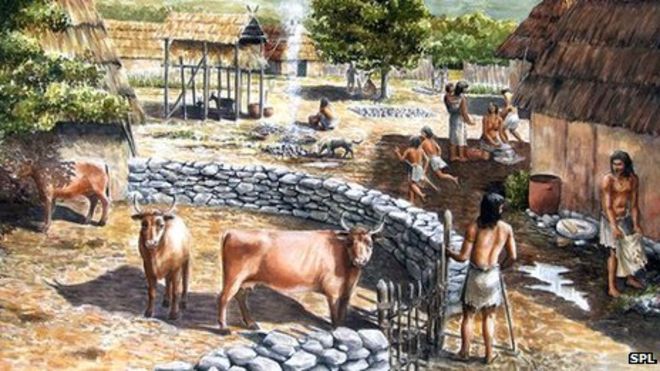The Paleolithic Era began nearly two hundred thousand years ago, and lasted for tens of thousands of years. The Neolithic Era followed, and was introduced with the rise of plant and animal domestications between twelve and six thousand years ago. The thought of the human species being around for so long is interesting to think about, especially given the fact that humans originated from ancestors in East Africa that date four to five million years back.1 Our ancestors must have been doing something right, considering the fact that the human species survived for such a long time without the technology, medicine, and overall knowledge that we have today. Once we realize that our ancestors from two hundred thousand years ago were so successful in their pattern of living during the Paleolithic Era, we must ask ourselves what changes occurred during the transitional period between the Paleolithic and Neolithic Eras, and whether or not those changes were good.
Humans living during the Paleolithic Era lived in egalitarian societies, that is, societies in which the inhabitants practiced political, economic, and social equality, where each individual in society held the same social status as all other members of society. This egalitarian society was made possible because of their way of life at the time. People lived in small communities of no more than a hundred, and they relied on hunting and gathering as their means of sustenance. They were necessarily migratory because of the limits of their environment, so there was not a real possibility of staying in one place for an extended period of time. Their migratory existence made the accumulate wealth impossible; in fact, wealth was an inconceivable concept for hunters and gatherers. As a result, everyone in society had the same economic standing; since there were no economic differences among individuals of society, there were no social classes. Nor was there the formation of political classes during this time either. Furthermore, everyone—men and women alike—played relatively equal roles in contributing to the survival and well-being of the community.2
This way of life and the egalitarian nature of society remained intact for centuries after the beginning of domestications. However, as hunter and gatherer societies transitioned to herding and farming, and hence to a sedentary lifestyle, a shift began that transformed those societies from egalitarian to stratified societies.3 This shift is one of the major distinctions between the Paleolithic and Neolithic Eras; again, this shift is a direct result of plant and animal domestication, or herding of animals and agriculture.

Agriculture gave the people of the Neolithic Era reassurance that their food supply would be constant; however, it also caused the rise of new issues that communities in the Paleolithic Era never dealt with. For example, the rise of agriculture prompted humans of the time to live in clustered societies, and therefore fostered the spread of parasites and several infectious diseases.4 Furthermore, since agriculture promoted a sedentary lifestyle, Neolithic societies were enabled to accumulate wealth in the form of surplus food supplies. This accumulation of wealth allowed for the social structure of the Neolithic Era to quickly become vastly different from that of the Paleolithic Era due to a focus on the “interests, behavior, and social role(s) of individuals versus a collective group of individuals.”5
Essentially, in the transition between the Paleolithic and Neolithic Eras, human society suffered a loss of social and economic equality and a general respect for all people, and replaced it with a system that required the separation of people based on superficial characteristics such as wealth, power, and gender. The interesting thing about the new class and gender distinctions that accompanied the beginning of the Neolithic Era is that for hundreds upon thousands of years, the human species had managed to exist without the use of class separations. Instead, it was the common practice of communities during the Paleolithic Era that there was no need to cause separation between persons because everyone made an equal contribution to the development and management of their small communities. Ironically, during the Neolithic Era, the rise of agriculture allowed the development of class divisions, as well as the establishment of governments that ruled harshly over society’s non-elites.6
These changes in social structure that arose during the Neolithic Era as a result of agriculture still persist in our societies today; there are still deep and widespread class divisions; there is still gender inequality, and there is still a sense of excessive elite control over the working class.7 Overall, social changes that occurred during the transition between the Paleolithic and Neolithic Eras exhibited a loss in important practices that we have only recently attempted to restore.
- Jerry H. Bentley, Herbert F. Ziegler, and Heather E. Streets-Salter, Traditions & Encounters: A Brief Global History From the Beginning to 1500, Fourth, vol. 1 (McGraw-Hill Education, 2016), 6-7. ↵
- Bentley, Ziegler, and Streets-Salter, Traditions & Encounters, 6-7. ↵
- Bentley, Ziegler, and Streets-Salter, Traditions & Encounters, 7-8. ↵
- Jared Diamond, “The Worst Mistake in the History of the Human Race,” Discover Magazine, May 1987, 65. ↵
- Ian Kuijt, Life in Neolithic Farming Communities: Social Organization, Identity, and Differentiation (New York: Springer Science & Business Media, 2002), 315-316. ↵
- Jared Diamond, “The Worst Mistake in the History of the Human Race”, 65. ↵
- Jared Diamond, “The Worst Mistake in the History of the Human Race.”, 65-66. ↵



59 comments
Rebekah Esquivel
I loved the title of this article, it is very relevant to what the article actually talks about. I find it very interesting how agriculture changed society and how it was initially ran so drastically. That before the time period where agriculture was established many people lived nomadic lives, not in big groups, and equal to everyone else. The rise of agriculture not only added a sense of wealth to society but created a division between men and women and established social classes. This was the change that causes many issues in todays society. It was very interesting to read and learn where this division came from.
Karina Nanez
How interesting that the effects of this social and economic change can still be felt today in our socioeconomic disparity and gender based inequality. Before reading this I had never known that a sedentary life style promoted the spread of infection and disease. You’re work is very in depth and well written, It makes me wonder if this shift was good for the human race but are importantly the earth.
Alondra Aviles
The changes from six thousand years ago to today have been minimal in many aspects. This article mainly portrays how our ancestors successfully survived their era by way of domestication. The comparison that I sought out from this article was that the main change has been the technological advances. Based off of our ancestors we have learned how to adapt and survive our “complicated” society. The gender differences have yet to completely change as of now. Women are still required to play a specific role in todays society much like six thousand years ago. Going back to domestication, plants and animals continue to be victim of our fast changing society although no longer going through major extinction in comparison to the Paleolithic era and Neolithic era. A very great informative and concise article.
Khoa Tran
No one would believe me if I tell them that the “old stone age” is the ultimate utopia that a lot of us dream of in modern society. It is mind blowing that the ”dream egalitarian lifestyle” was practiced in ancient world where everyone has political, economic, and social equality. Sadly, this was lost during the transition to the “new stone age”. It does make sense that surplus food supplies accumulate wealth which lead to separation in people based on wealth and power.
Aaiyanna Johnson
Beautifully written paper in that connecting the old with present times. I find it very interesting how even though the odds were stacked against them they found a way through. It’s compelling to learn that given their limits they survived, and that their systems for ruling survived for so long. I further believe we as Americans can take notes on their equity practices.
Ezequiel De La Fuente
This article brought light to why we have the problems we still face today. In a way, one would think that the Neolithic Era brought upon more civilized people, but it also brought upon more issues. I wonder if it would ever be possible to reverse our ways and live truly “equal’ again as we did in the Paleolithic Era. This article was both very informative and interesting to read! It truly educated me on what was lost during our transition to a more civilized.
Teresa Valdez
It is so interesting that early civilizations had social and economic equality. In that respect, society has taken giant leaps backwards. This article lays out the pros and cons of the development of civilizations very well. It is easy to understand. The article argues that humans traded in agriculture and social prosperity for disease, social inequality, and class divisions. It does not seem fair at all, as we still struggle with these problems today. However, without agriculture, the land would not be able to sustain permanent homes, large populations, and complex civilizations. It is a topic that is great food for thought.
Maria Callejas
First of all, great title! It gives an accurate glimpse of the core of your article. Also, good job with your topic sentences at the beginning of each paragraph. It is impressive to see how as we optimized our lifestyle with agriculture and domestication, we lost the egalitarian harmony early humans possessed. By defining the “migratory existence”, you were able to illustrate precisely what lead to the change mentioned before. I really enjoyed your conclusion, in the sense that you talked about today’s society, and how we still live within societal and gender barriers. Overall, amazing work!
Alexis Renteria
Its crazy how a switch from hunting to gathering can change so many things. From both genders being equally important by contributing food and plants, to men being seen as more important in their Neolithic society. Furthermore I wonder if this could have been avoided. Why couldn’t we have gone through civilization with both genders being as equal as they were before? However I’m glad that were working towards both genders being seen as equal, the way we should have been from the beginning.
Belene Cuellar
It’s amazing how much we as humans have “adapted” over the past couple of years. Who would have thought that there was once a time were humans were in a state of equality. A time where we were not obsessed with materialism and clouded by greed. Throughout this article, the author brings to light the kind of society we live in today. She makes the reader question how evolved as a society we really are. This article made me realize how much technology and social classes has affected our mentality and our priorities.